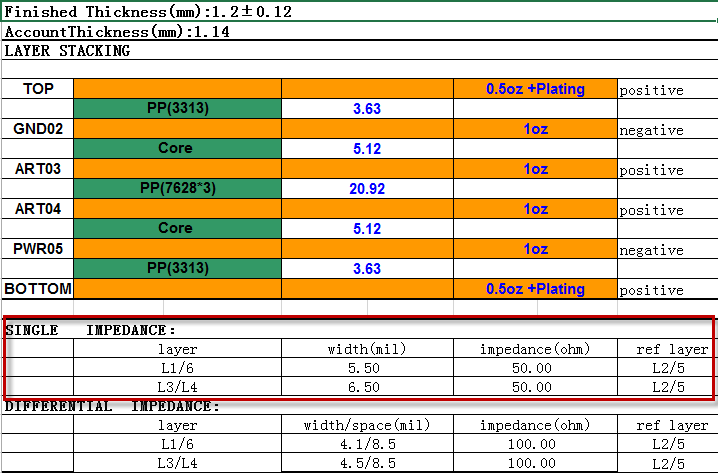Why PCB controls 50 ohm impedance
During PCB design, before routing, we usually stack the project we want to design, calculate the impedance based on the thickness, substrate, number of layers and other information, and generally get the following figure after calculation.

As can be seen from the above figure, the single-ended network in the design is generally controlled by 50 ohms, so many people will ask, why is it required to be controlled by 50 ohms instead of 25 ohms or 80 ohms? First of all, 50 ohms is selected by default, and everyone in the industry accepts this value. Generally speaking, it must be a standard set by a recognized organization, and everyone designs according to the standard.
A large part of electronic technology comes from the military. First of all, the technology is used for military use, and gradually it is transferred from military to civilian use.
In the early days of microwave application, during World War II, the choice of impedance was completely dependent on the needs of use, and there was no standard value. With the advancement of technology, impedance standards need to be given to strike a balance between economy and convenience.
In the United States, the most commonly used conduits are connected by existing measuring rods and water pipes. 51.5 ohms are very common, but the adapters and converters seen and used are 50-51.5 ohms. In order to solve these problems with the joint army and navy, an organization called JAN was established (later DESC organization), which was specially developed by MIL. After comprehensive consideration, 50 ohms was finally selected, and the relevant conduits were manufactured and converted into standards for various cables.
At this time, the European standard was 60 ohms. Soon after, under the influence of companies that dominated the industry such as Hewlett-Packard, Europeans were forced to change, so 50 ohms eventually became a standard in the industry and became a convention. In order to match the impedance of PCBs connected to various cables, they were finally required to follow the 50 ohm impedance standard.
Secondly, the formulation of general standards is based on the comprehensive consideration of PCB production technology, design performance and feasibility.
From the perspective of PCB production and processing technology, considering the equipment of most existing PCB manufacturers, it is relatively easy to produce PCBs with 50 ohm impedance.
From the impedance calculation process, it can be seen that too low impedance requires a wider line width and thinner dielectric or larger dielectric constant, which is difficult to meet in terms of space for current high-density boards; too high impedance requires a thinner line width and thicker dielectric or smaller dielectric constant, which is not conducive to the suppression of EMI and crosstalk. At the same time, the reliability of processing for multilayer boards and mass production will be relatively poor.
Controlling 50 ohm impedance In the environment of using common boards (FR4, etc.) and common core boards, products with common board thicknesses (such as 1mm, 1.2mm, etc.) can be designed with common line widths (4~10mil), which is very convenient for board factories to process, and the requirements for the equipment used for its processing are not very high.
From the perspective of PCB design, 50 ohms is also selected after comprehensive consideration. From the performance of PCB routing, generally low impedance is better. For a transmission line with a given line width, the closer the distance to the plane, the corresponding EMI will be reduced, and crosstalk will also be reduced accordingly.
However, from the perspective of the entire signal path, the most critical factor that needs to be considered is the chip's driving capability. In the early days, most chips could not drive transmission lines with an impedance less than 50 ohms, and transmission lines with higher impedances were inconvenient to implement, so 50 ohms were used as a compromise.
Therefore, 50 ohms is generally selected as the default value for single-ended signal control impedance in normal situations.
